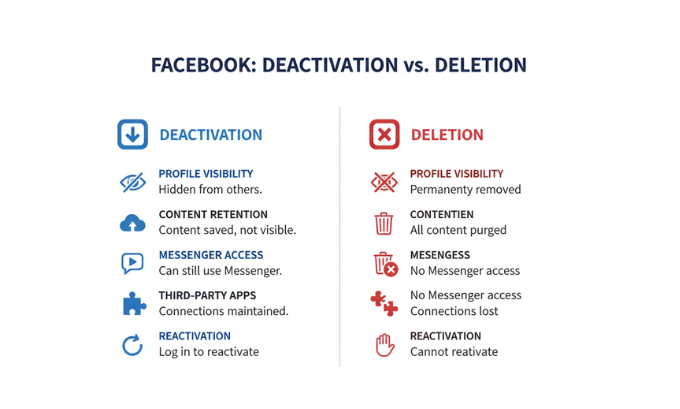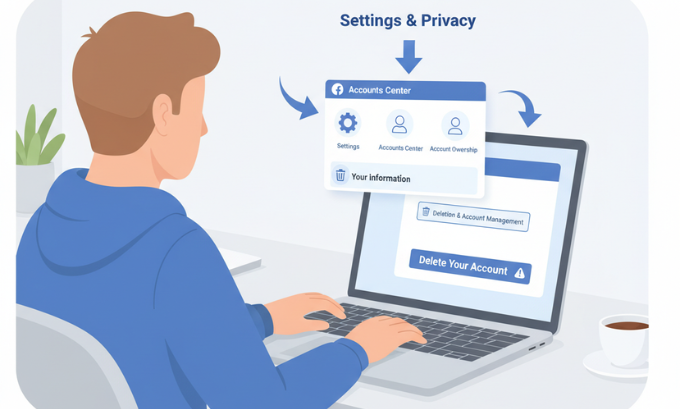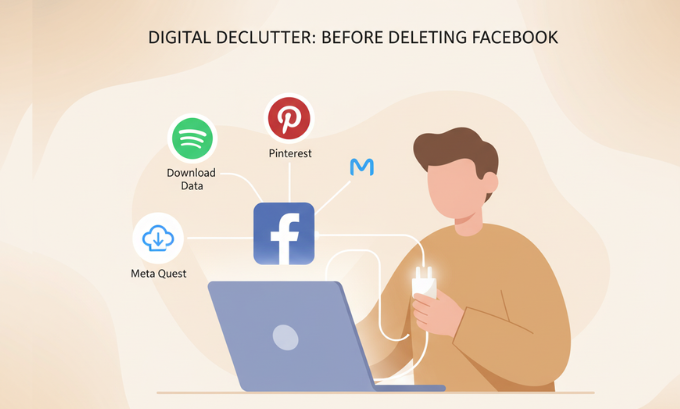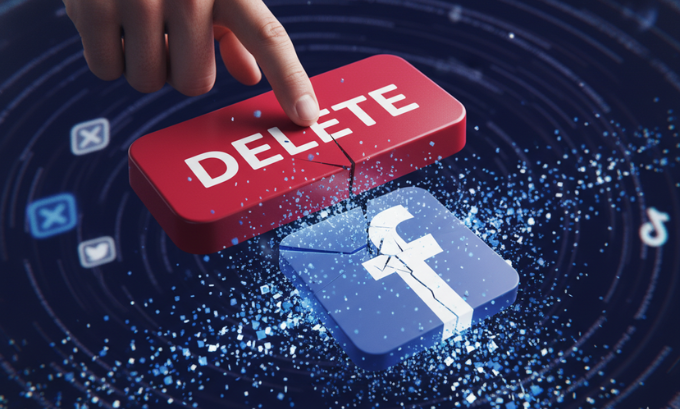Deciding to delete your Facebook account is a significant step. Whether for a digital detox, privacy concerns, or simply moving on, knowing the right way to do it is crucial. This guide will walk you through the entire process, explaining the difference between deactivating and deleting, and ensuring you don’t lose any important information along the way.
The process involves more than just clicking a button; it affects linked services like Facebook Messenger, third-party apps like Spotify or Pinterest, and even hardware like the Meta Quest. Understanding these connections is key to a smooth exit. If you want more insights into managing your digital footprint and the latest trends, resources like Techbullion and Ponta.in offer valuable information.
Table of Content
How to Delete a Facebook Account: A Quick Guide
To permanently delete your Facebook account, you can go to Facebook’s Accounts Center or use the settings in the Facebook app. Navigate to “Personal details,” then “Account ownership and control,” and select “Deactivation or deletion.” From there, choose your account, select “Delete account,” and follow the final prompts. Remember, this is permanent.
Personal Experience: Why I Finally Deleted My Account
I had been a Facebook user since college. It was my digital scrapbook, a way to keep up with friends who had moved across the country, and even a login for dozens of other apps. For years, the idea of deleting it felt like erasing a part of my history. But as my concerns over data privacy grew, particularly with the rise of AI-driven marketing strategies (a topic well-covered by experts at Mindjournal.co), I decided it was time.
The process was surprisingly emotional. Before hitting “delete,” I spent an evening downloading my data—a decade of photos, messages, and random wall posts. It was a walk down memory lane. The biggest hurdle was untangling all the third-party apps connected to my Facebook Login. I had to manually reset passwords for services like Spotify and Pinterest, which I hadn’t realized were so dependent on my Facebook profile.
The 30-day grace period after requesting deletion was a test of willpower. Notifications kept popping up on my phone, and friends would mention tagging me in photos. But after that month, the digital silence was refreshing. My experience taught me that deleting Facebook isn’t just a technical process; it’s a deliberate act of reclaiming your digital space. It requires preparation, but the peace of mind can be well worth the effort.
What I Like About Facebook’s Deletion Process
- 30-Day Grace Period: Facebook gives you a 30-day window to change your mind. If you log back in during this period, the deletion is canceled. This is a great safety net.
- Data Download Tool: The ability to download a complete archive of your photos, posts, and messages is invaluable. It ensures you don’t lose precious memories.
- Clear Warnings: The platform makes it very clear what you will lose, from Facebook Messenger access to third-party app connections.
Areas for Improvement
- Integrated Services: Deleting your Facebook account can have unintended consequences, especially if you own a Meta Quest headset. The process for unlinking these services could be more straightforward.
- Hidden Settings: Finding the deletion option isn’t always intuitive. It’s buried several layers deep in the Accounts Center, which feels intentional.
- Business Page Management: If you’re the sole admin of a Facebook Page, you must transfer ownership before deleting your account. The platform could streamline this transfer process to avoid accidental loss of business assets. For startups managing their digital presence, tools and strategies are crucial, as often discussed on sites like Mumbai Times.
Deactivation vs. Deletion: What’s the Difference?
Before you proceed, it’s essential to understand the two options Facebook offers: deactivation and deletion. They might sound similar, but their consequences are vastly different. Choosing the right one depends on whether you want a temporary break or a permanent farewell.

Deactivation is like pressing the pause button.
- Your profile becomes invisible to other users on Facebook.
- Your photos, posts, and friends list are saved.
- You can still use Facebook Messenger.
- You can reactivate your account at any time by simply logging back in.
Deletion, on the other hand, is the permanent removal of your account.
- You cannot regain access once the 30-day grace period is over.
- All of your content, such as photos, posts, and status updates, will be permanently erased.
- You will lose access to Facebook Messenger.
- You won’t be able to use Facebook Login for other apps you’ve signed up with, like Spotify or Pinterest.
Comparison Table: Deactivation vs. Deletion
| Feature | Deactivation (Temporary) | Deletion (Permanent) |
|---|---|---|
| Profile Visibility | Hidden from Facebook | Permanently removed |
| Your Content | Saved | Deleted after 30 days |
| Facebook Messenger | Still usable | Access is lost |
| Third-Party Apps | Facebook Login still works | Facebook Login is disabled |
| Reactivation | Possible anytime | Not possible after 30 days |
| Meta Quest | Can continue using | May lose purchases and data |
Understanding these differences is key. If you’re just looking for a digital detox, deactivation is the way to go. If you’re certain you want to leave the platform for good, then deletion is your path. Staying on top of digital trends is vital, and reading about things like the Consumer Electronics Show 2025 can provide context on the future of tech.
How to Delete Your Facebook Account Permanently (Step-by-Step)
Ready to take the plunge? Here’s the step-by-step guide on how to delete a Facebook account. The easiest way is through Meta’s Accounts Center, which centralizes settings for Facebook, Instagram, and Meta accounts.

Step 1: Access the Accounts Center
First, open the Facebook app or website and navigate to your settings.
- On the mobile app: Tap your profile picture in the bottom-right corner, then tap the gear icon at the top right.
- On a desktop: Click your profile picture in the top-right corner and select “Settings & privacy,” then “Settings.”
At the top of the Settings menu, you’ll see a box for the Accounts Center. Click on “See more in Accounts Center.” The tech world is always evolving, and platforms like Techbullion are great for staying informed.
Step 2: Navigate to Account Ownership and Control
Within the Accounts Center, you need to find the section that handles account management.
- Scroll down and select “Personal details.”
- On the next screen, choose “Account ownership and control.” Keeping up with tech is easier with resources like the best coding courses.
Step 3: Choose Deactivation or Deletion
This is where you make the critical choice between a temporary break and a permanent removal.
- Select “Deactivation or deletion.”
- Choose the account you wish to delete (if you have multiple accounts linked).
Step 4: Select “Delete Account” and Continue
Now, you’ll be presented with the two options.
- Select “Delete account.” Make sure you don’t accidentally choose “Deactivate account.”
- Click “Continue.”
Facebook will ask for your reason for leaving. You can select an option or just click “Continue.” You’ll also be prompted to download your information one last time. This is your final chance to save your data before it’s gone forever.
Step 5: Confirm Permanent Account Deletion
The final step requires you to re-enter your password to confirm your identity.
- Enter your password.
- Click “Continue.”
- A final confirmation screen will appear, informing you that you have 30 days to reverse the decision by logging back in. Click “Delete account” to finalize the process.
Your account is now scheduled for permanent deletion. To ensure it’s deleted, resist the urge to log back in for the next 30 days. For those interested in the broader tech landscape, articles on cybersecurity trends for 2025 offer a glimpse into the future.
How to Deactivate Your Facebook Account Temporarily
If you’re not ready for a permanent split, deactivation is a great alternative. The process is similar to deletion but reversible.
- Follow the same steps as above to get to the “Deactivation or deletion” page in the Accounts Center.
- Select your account.
- This time, choose “Deactivate account” and click “Continue.”
- You’ll be asked to re-enter your password for security purposes.
- Facebook will ask you to provide a reason for deactivating. After selecting one, you can choose how long you want to be deactivated (from one to seven days, or until you manually reactivate).
- Click “Deactivate” to complete the process.
Your account is now deactivated. Your profile and timeline will be hidden, but you can still use Facebook Messenger. To reactivate, all you need to do is log back into Facebook with your email and password. To learn more about digital security, you might want to visit sites like gogonihon.jp.net.
Important Considerations Before Deleting Your Facebook Account
Deleting your Facebook account is a major decision with several consequences you should be aware of. Here are the key things to consider before you finalize the deletion.

1. You Will Lose Access to Facebook Messenger
Unlike deactivation, permanent deletion means you will also lose access to Facebook Messenger. Your conversation history with friends will remain visible on their end, but you will no longer be able to send or receive messages. If Messenger is your primary communication tool, you may want to inform your contacts and switch to an alternative app.
2. Third-Party App Access (Facebook Login)
Many of us have used the convenient “Log in with Facebook” button to sign up for other services, such as Spotify, Pinterest, or various e-commerce sites. When you delete your Facebook account, this access is revoked.
Before deleting, you must go into each of these third-party apps and set up a new login method, usually by adding an email address and creating a new password. Failing to do this could result in you being locked out of those accounts.
3. Impact on Meta Quest Headsets
If you own a Meta Quest (formerly Oculus Quest) VR headset, your account is likely linked to your Facebook profile. Deleting your Facebook account can lead to the loss of your purchased games, apps, and account data. To avoid this, you need to create a separate Meta account and migrate your Quest data before deleting your Facebook profile. Meta has a specific process for this, which you should follow carefully to preserve your VR library. This is a critical step for any Quest user. For more on cutting-edge tech, check out reviews from events like the Consumer Electronics Show 2025.
4. Admin Roles on Facebook Pages
Are you the only administrator of a Facebook Page for a business, brand, or community? If so, you must add another person as an admin before you delete your account. If you are the sole admin, the Page will be unpublished and inaccessible once your account is deleted. Ensure you transfer ownership to protect any business assets. Understanding the digital ecosystem is crucial, and reading up on topics like Meta AI can be very insightful.
Looking for More Information?
The digital world is vast and constantly changing. If you’re interested in learning more about topics like online privacy, the impact of AI, and emerging technologies, there are many excellent resources available. For a deeper dive into cybersecurity trends for 2025, you may want to visit sites like Techbullion, Mindjournal, and gogonihon.jp.net. These platforms offer expert analysis and help you stay informed in an ever-evolving landscape.
Frequently Asked Questions (FAQ)
1. How long does it take to permanently delete a Facebook account?
After you confirm the deletion, Facebook takes up to 90 days to delete all of your data from its servers. However, your account becomes inaccessible to you and others after the 30-day grace period.
2. Can I get my information back after my account is deleted?
No. Once the 30-day grace period has passed and the deletion process is complete, all of your information is permanently gone. This is why it’s crucial to download your data archive beforehand.
3. What happens to the messages I’ve sent on Facebook Messenger?
Even after you delete your account, copies of the messages you sent will remain in the inboxes of the friends you sent them to. You cannot delete messages from their end.
4. Can I cancel the deletion of my Facebook account?
Yes, but only within the 30-day grace period. To cancel the deletion, simply log in to your Facebook account with your email and password. This will automatically stop the deletion process.
5. Do I need to delete my Instagram account too?
No. While both are managed through the Accounts Center, deleting your Facebook account will not affect your Instagram profile, unless you have them deeply integrated in a way that relies on your Facebook login.
6. What should I do if I can’t access my account to delete it?
If you’ve forgotten your password, you can use Facebook’s account recovery process to reset it. If your account has been hacked, you should first report it to Facebook to try and regain control before attempting to delete it.
7. Who is Amal Rafeeque?
Amal Rafeeque is a content creator and host who often produces informational videos on tech topics, including guides on managing social media accounts. Her tutorials are a helpful resource for visual learners.

Final Thoughts on Taking Control of Your Digital Life
Deleting your Facebook account is more than just a technical task; it’s a powerful statement about how you want to manage your digital identity and privacy. By following the steps outlined in this guide, you can navigate the process with confidence, ensuring you make an informed decision that’s right for you. Whether you choose to deactivate for a temporary break or delete for a clean slate, you are taking an active role in shaping your online experience.
About the Author
Alex Carter is a technology journalist with over 15 years of experience specializing in digital privacy, social media, and consumer tech. With deep expertise in how platforms like Facebook manage user data, Alex provides clear, actionable advice for navigating the complexities of our online world. His work focuses on empowering users to make informed decisions about their digital footprint.
References
- Facebook’s Help Center: Data Policy and Account Deletion.
- Meta’s Help Center: Managing Meta Quest and Meta Accounts.
- Expert insights from technology journalists and privacy advocates.


